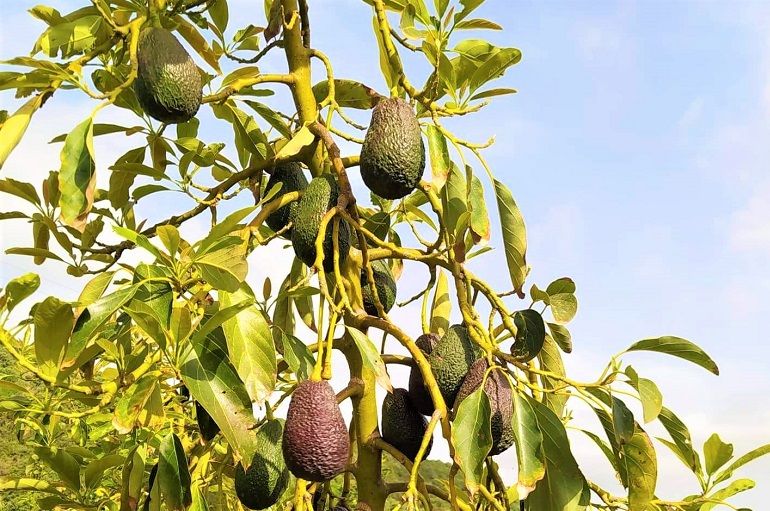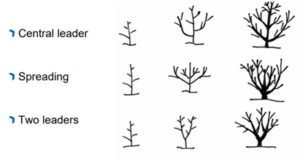Training and Pruning of Avocado Tree

This post is also available in:
This post is also available in:
![]() Español (Spanish)
Español (Spanish) ![]() Français (French)
Français (French) ![]() Deutsch (German)
Deutsch (German) ![]() हिन्दी (Hindi)
हिन्दी (Hindi) ![]() العربية (Arabic)
العربية (Arabic) ![]() Türkçe (Turkish)
Türkçe (Turkish) ![]() 简体中文 (Chinese (Simplified))
简体中文 (Chinese (Simplified)) ![]() Ελληνικά (Greek)
Ελληνικά (Greek) ![]() Português (Portuguese (Brazil))
Português (Portuguese (Brazil))
How to train a young Avocado Tree
Like many other fruit-bearing trees, avocados need to be trained to obtain a desirable shape/structure and size that will maximize production, balance yield and quality, and facilitate its cultivation. Before any action is taken, as a farmer myself, I would recommend that you take one step back and consider the needs and peculiarities of your field. Factors like the position of the field, the direction of the planting rows (wind exposure), the soil depth and fertility, the irrigation system, as well as the variety cultivated, the plant spacing, and the available means for harvesting should be taken into account when forming the permanent structure of the limbs.
Training should start already from the first years of the orchard establishment. This is especially important when training for the central-leader system. If the trees are grown in a field with a slope, it is best to keep them shorter. This should also be done when the field has shallow soil or a very high water horizon.
There are three main growing systems for avocado:

Source: https://www.seeka.co.nz/vdb/document/398
Usually, avocado growers choose the “spreading” system. In this case, one of the training priorities is to create one strong tree trunk that can withstand the future weight of a mature tree and a high yield. The main branches should start about 70 cm from the ground.
Branches that have more than half the thickness of the central shoot (future trunk) must be removed (2). Around four strong branches are also selected to be the primary limbs. Generally, avocado is irrigated with drip irrigation systems. However, some farmers choose to install and use sprinklers. In this case, it is essential to have one single, clean trunk, with the branches starting a bit higher, so they do not interfere with the water distribution.
To facilitate harvesting from the ground, avocado farmers want to promote lateral growth of the trees. The farmer should take all necessary actions to encourage lateral growth and multiple framework branching. Terminal shoots should be pinched at the beginning of the second growing season. These should be repeated until the trees have obtained the desired structure and height (3).
However, I have witnessed many cases where the grower did not have the available space due to close planting distances and, to avoid losing any yield, allowed the vertical growth of the trees. The result was that the trees became very tall, the fruits were developing in the upper 2/3 of the tree, and the use of specialized machinery and ladders was necessary for harvesting (4). I highly advise any farmer to avoid such practice and consider the final size of the trees when planting their avocado orchard. Fruit picking may be facilitated by forming a tree with a low vase type of head. However, such “open” formation should be avoided in areas exposed to strong winds because limbs can break.
Young trees need all the nutrients and water they can get to maintain their quick-growing rhythm. As a result, the farmer must often remove all suckers growing from the tree basis. Similarly, all branches grown below the graft or bud union should be removed if the avocado is grafted.
You may avoid pruning young avocado trees very strictly (excessively) since this will delay the production phase even more. Finally, after the first three years of training, the farmer should not neglect its trees and perform pruning annually.
Pruning avocado trees: A simple procedure that should not be neglected
Generally, avocado trees do not need too much pruning after the 4th year of growth in the field. However, some pruning is vital for a high and stable avocado yield over the years since it gives control of flowering (productive) wood (1). It can influence the amount and quality of fruit production and maintain the height and formation of the trees. Generally, avocado trees tend to become tall, and if this tendency is not under control, cultivation activities like harvesting will become very difficult in the years to come. As a result, I trim the tops of the branches every two years to keep my avocado trees at a maximum height of 10 m (32.8 ft). This happens after harvest.
Before starting, you should walk around the tree and observe its canopy. Then you may come closer to the trunk, put your back against it and observe the interior of the canopy. This will reveal to you all the necessary parts that need to be cut.
The principles to keep in mind when pruning an avocado tree are the following:
- Remove all suckers that grow from the tree’s base and rootstock.
- Any intervention should be applied only when the tree is dormant and before the flowering buds start developing. Too late pruning (late in the spring) can result in nutrient loss and exposure of the sensitive new vegetation to the sun (sunburns are expected). On the other hand, pruning too early (end of summer) may lead to frost damage to the newly developed branches during the winter (4).
- Prune dead and infected wood to reduce the spread of the infection to healthy plant parts during the following season.
- Try to keep a more open formation with branches of lateral growth. Remove any branches that go downwards, inwards, or pinch out the terminal buds or the branches that grow straight up. Trim the branches by 1/3 or 1/4 of their size.
- If a vigorous secondary limb is shading or leads a primary lateral down, it should be (partially) removed (5).
- Avoid pruning the tree too heavily because it will lead to excessive leaf loss and favor vegetative growth against fruit formation.
- You can open “windows” to improve aeration and sun penetration that will help flowering and fruit set. In regions with very high solar radiation and heatwaves, it is better to leave enough vegetation to offer shade and protect the branches, the trunk, and the fruits from sunburns.
- It is better to thin the number of branches in order to maintain a 30-38 cm (12-15 in) distance between them. This will allow enough light to enter the tree canopy and simultaneously reduce the friction and bumps between branches when strong winds prevail.
- Rejuvenate the branches to keep them productive (new fruit-bearing wood). Depending on the variety, you may need to remove one major limb per year (6).
- Fruit thinning is not necessary for avocados, in my opinion.
Except for the training (formation pruning) and the annual pruning, there might be a need to perform regenerative pruning in very old trees where productivity has declined. Additionally, in high-density orchards, growers often choose to remove trees after seven years, to allow the growth of the remainings (1). In every case, the farmer should consult a local agronomist and find the more suitable strategy and pruning method that matches his/her variety, field, goals, and local environmental conditions.
References
- https://www.seeka.co.nz/vdb/document/398
- https://www.avocadosource.com/Journals/SAAGA/SAAGA_1996/SAAGA_1996_PG_73-76.pdf
- https://www.jica.go.jp/project/english/kenya/015/materials/c8h0vm0000f7o8cj-att/materials_02.pdf
- http://ipm.ucanr.edu/PMG/GARDEN/FRUIT/CULTURAL/avocadotraining.html
- http://www.avocadosource.com/CAS_Yearbooks/CAS_20_1935/CAS_1935_PG_098-103.pdf
- https://www.daf.qld.gov.au/business-priorities/agriculture/plants/fruit-vegetable/fruit-vegetable-crops/avocado/planting-and-growing-avocados
History, Nutritional Value and Plant Information of Avocado
All Avocado Varieties Explained- Characteristics and Advantages
Avocado Tree Climate and Soil Requirements – Planting Avocado Trees
Avocado Tree Propagation and Pollination
Avocado Tree Water Requirements and Irrigation Systems
Avocado Fertilizer Requirements
Training and Pruning of Avocado Tree
Avocado Harvest, Yield per hectare and Storage
Avocado tree Pest and Diseases – Avocado Weed Management








































































